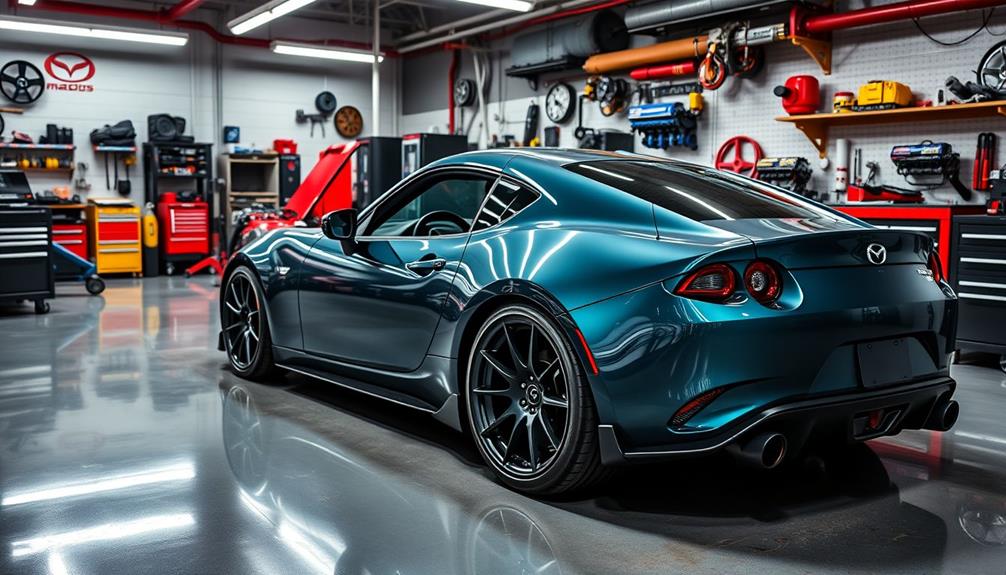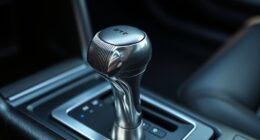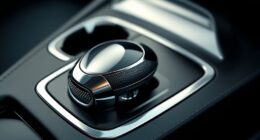Tuning your Mazda RX-7 lets you release the full potential of its rotary engine. Start with engine and turbo upgrades, like a big single turbo, to boost power considerably. Don't forget to enhance your fueling system; larger injectors and high-flow pumps are essential. Selecting a reliable aftermarket ECU is critical for effective tuning. Cooling modifications, like alloy radiators, help manage heat during intense drives, while a custom exhaust system improves airflow. As you explore this process, be prepared for challenges involving timing and fuel pressure. Stick around, and you'll discover more insights to fine-tune your RX-7's performance.
Key Takeaways
- Upgrade to a big single turbo, such as Garrett G35 or EFR7670, for significant performance boosts of 500-600bhp.
- Enhance fuel delivery with larger injectors (1600cc+) and high-flow fuel pumps to support high power levels effectively.
- Select an appropriate aftermarket ECU and work with skilled tuners for optimal mapping and engine performance tailored to rotary specifics.
- Utilize cooling enhancements like alloy radiators and oil coolers to manage heat and prevent engine damage during spirited driving.
- Monitor crucial parameters like ignition timing, boost control, and exhaust gas temperatures to ensure safe and efficient engine operation.
Overview of the Mazda RX-7 FD
The Mazda RX-7 FD, a standout in the world of performance cars, was produced from 1992 to 2002 and features the iconic 13B-REW twin rotor twin turbo engine.
With factory outputs ranging from 252bhp to 276bhp, this rotary engine is celebrated for its lightweight design and thrilling performance. The RX-7 FD has carved out a niche in various motorsport disciplines, excelling in drag racing and drifting thanks to its exceptional handling and agility.
While the factory twin turbo setup serves enthusiasts well, many see it as a limitation for power upgrades. This often leads to single turbo conversions, allowing you to access the true potential of the RX-7's engine.
With the right tuning modifications, you can push the base engine to achieve impressive four-figure power numbers, making the RX-7 FD a highly sought-after platform for performance enthusiasts.
The RX-7's distinct rotary engine characteristics and vibrant tuning community further enhance its reputation as one of the best Japanese performance cars.
If you're looking to immerse yourself in the world of Mazda RX-7 tuning, you're in for an exhilarating journey that promises both challenges and rewards.
Engine and Turbocharger Upgrades
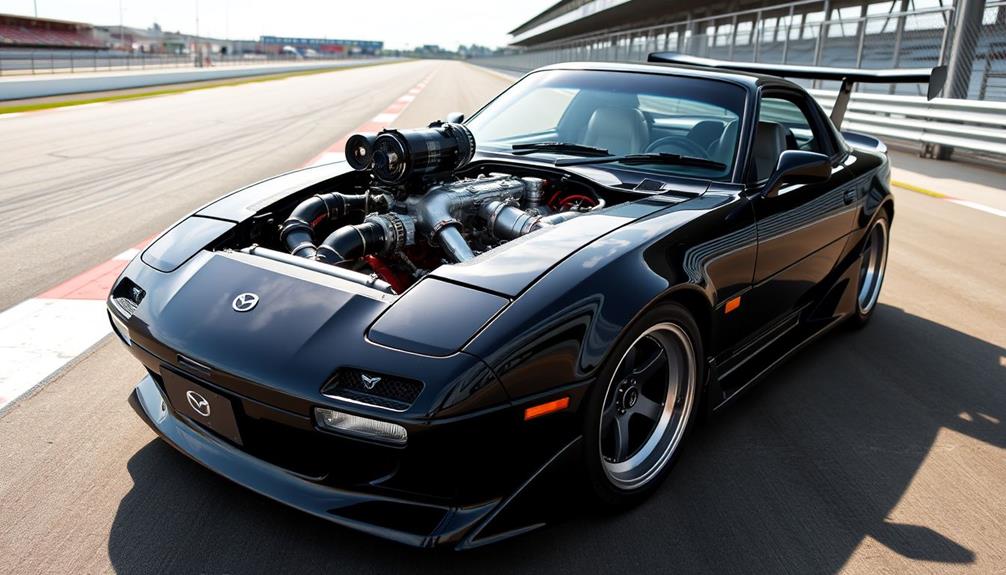
Upgrading the engine and turbocharger in your Mazda RX-7 FD can release significant performance potential, transforming it into a powerhouse on the road or track.
The factory twin turbo setup limits your car's power output, so consider switching to a big single turbo for enhanced performance characteristics. Popular options like the Garrett G35 or EFR7670 feature compressor inducers around 60mm, enabling you to achieve impressive power levels between 500-600bhp.
If you're aiming for over 550bhp, you'll need larger turbos and additional modifications to guarantee your rotary engine remains drivable and reliable.
While hybrid turbos may seem appealing, they often struggle to exceed 400bhp, making them less justifiable for serious upgrades. Instead, investing in a complete turbo kit from reputable companies like SAS Autoworks or Turblown Engineering—typically costing over $5000—can provide the performance enhancements you're looking for.
Remember to adjust your fuel pressure and other supporting systems accordingly to maximize the potential of your new turbocharger.
Fueling and Injection Systems
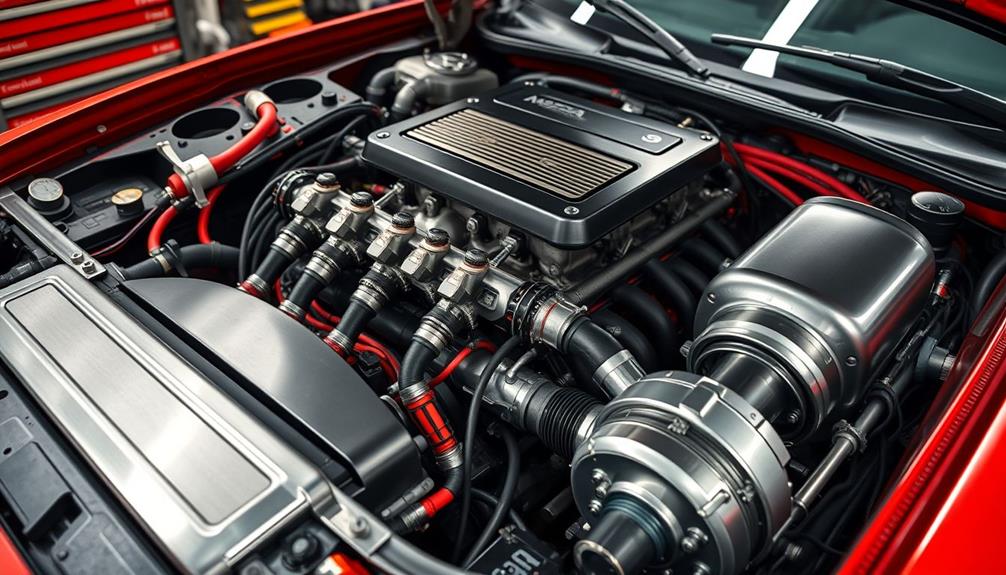
For ideal performance in your Mazda RX-7, its fueling and injection systems must be carefully upgraded to match your power goals. The stock setup includes two 550cc and two 850cc injectors, but if you're pushing for significant power, you should consider upgrading to 1600cc injectors or larger.
High-flow fuel pumps are vital in this upgrade, ensuring your engine gets enough fuel under demanding conditions. Aftermarket fuel inlets can also support eight or twelve injector setups for even more extreme power applications.
When selecting fuel, always opt for high-octane race fuel, as rotary engines are sensitive to lean conditions. This choice is essential when running high boost levels. Integrating a flex fuel sensor into your RX-7 allows for real-time ECU adjustments based on ethanol content, optimizing performance across various fuel types.
Here's a quick reference table for your fueling upgrades:
| Component | Recommendation |
|---|---|
| Injectors | 1600cc or larger |
| Fuel Pumps | High-flow replacements |
| Fuel Type | High-octane race fuel |
These upgrades will help you push your RX-7's performance to new limits.
Tuning and ECU Management
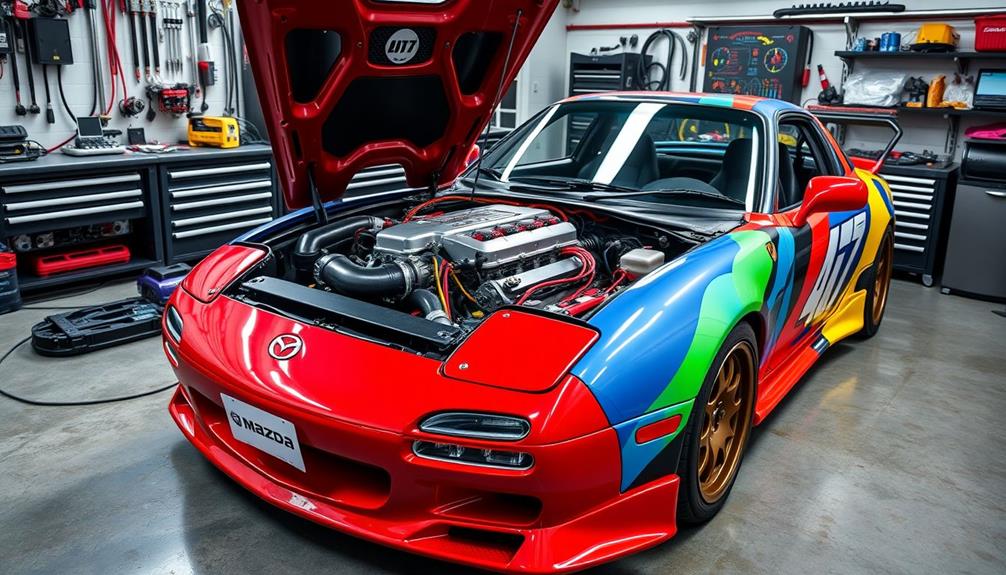
When tuning your Mazda RX-7, selecting the right aftermarket ECU is essential for releasing its full potential.
Effective mapping techniques tailored to rotary-specific parameters can make all the difference in performance.
Don't underestimate the importance of skilled tuning to guarantee your engine runs smoothly and efficiently.
Aftermarket ECU Selection
Selecting an aftermarket ECU is often a significant step in maximizing the performance of your Mazda RX-7. Aftermarket ECUs, like Haltech and Link, offer advanced tuning capabilities tailored specifically for rotary engines, allowing you to achieve substantial power increases over factory units.
Effective ECU mapping is essential; a poorly configured ECU can seriously hinder performance. That's why it's important to choose a skilled mapper with experience in rotary engines to guarantee reliable results.
An effective engine management system should allow you to monitor and adjust key parameters like fuel delivery and ignition timing. These features are fundamental for performance optimization and preventing detonation, which could damage your engine.
Community feedback on various aftermarket ECUs can vary widely, so consider user experiences when selecting a compatible unit that enhances your driving satisfaction.
Lastly, remember that regular updates and tuning adjustments to your ECU are necessary to accommodate any changes in engine performance and modifications. This guarantees your RX-7 operates efficiently and reliably under various conditions.
Investing in the right aftermarket ECU will set you on the path to revealing your rotary engine's true potential.
Effective Mapping Techniques
Effective mapping techniques are essential for releasing your Mazda RX-7's full potential. Properly executed effective ECU mapping can maximize performance, enhance reliability, and elevate your driving experience.
Here are four key considerations:
- Choose a Skilled Mapper: Look for someone experienced with rotary engines. They'll understand the nuances of tuning, especially ignition timing adjustments.
- Utilize Aftermarket ECUs: Options like Haltech or Link offer advanced mapping capabilities, allowing for greater power increases compared to factory units.
- Regular Data Logging: Track engine parameters such as boost levels, exhaust gas temperatures (EGTs), and fuel pressure during tuning sessions. This helps guarantee stability and prevents potential engine damage.
- Adjust Air-Fuel Ratios: Continuous tweaks to air-fuel ratios (AFR) are critical, particularly at higher boost levels. This practice keeps performance ideal and reduces the risk of detonation, an issue rotary engines are especially sensitive to.
Rotary-Specific Parameters Importance
Tuning a rotary engine requires a deep understanding of its unique parameters, as they greatly influence both performance and reliability. One important aspect is ignition timing; for turbocharged setups, you'll often run around 30° BTDC, while naturally aspirated engines typically require 18-26° BTDC. This precision helps optimize performance and prevent detonation.
Effective ECU management is equally essential. You need to pay close attention to rotary-specific parameters like air-fuel ratios (AFR) and boost control settings, which can directly impact your engine's reliability. Skilled tuners familiar with rotary dynamics are key for fine-tuning these aspects to avoid catastrophic failures.
Monitoring EGT (Exhaust Gas Temperature) is important, too. Keeping EGTs under 1100°C not only prevents seal failure but also indicates the effectiveness of your tuning adjustments. Utilizing aftermarket ECUs, like Haltech or Link, can provide you with advanced capabilities that surpass factory limitations, allowing for better control over fuel delivery and ignition timing.
Lastly, tailor your fuel systems to fit rotary engines. Larger injectors (1600cc or more) and high-flow fuel pumps are often necessary to support power levels exceeding 500bhp, preventing dangerous lean conditions.
Cooling and Exhaust Modifications
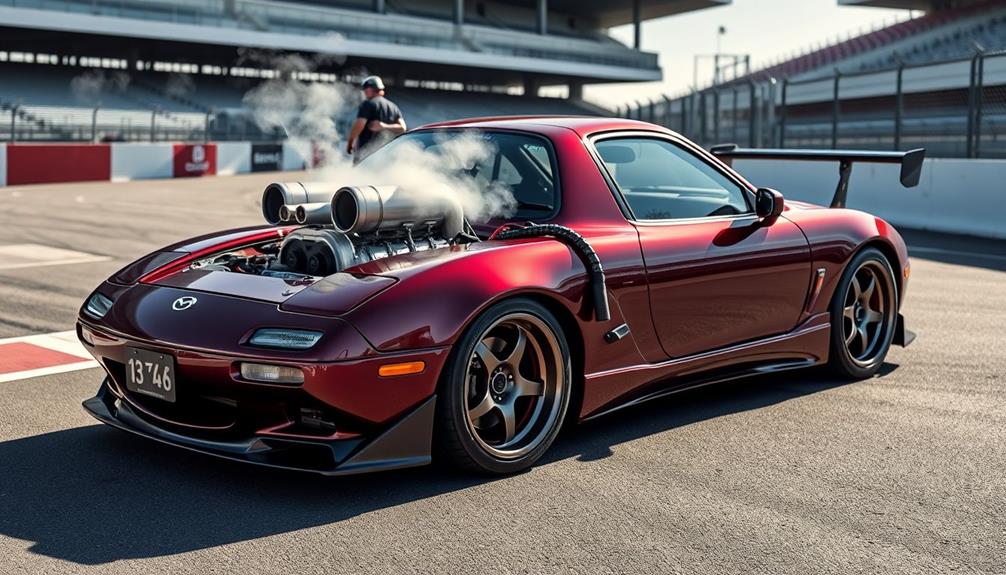
When it comes to maximizing the performance of your Mazda RX-7, upgrading the cooling and exhaust systems is vital. Rotary engines are particularly sensitive to overheating, so ensuring ideal cooling is essential for performance.
Here are four important modifications to take into account:
- Alloy Radiators: Installing an alloy radiator enhances cooling efficiency, helping manage the heat generated during spirited driving.
- Oil Coolers: An oil cooler maintains lower oil temperatures, preventing overheating and potential engine damage.
- Exhaust System Upgrade: Upgrading from a 2.5-inch to a 3-inch exhaust improves airflow, providing noticeable power gains. Custom systems may be necessary if you're pushing beyond 500bhp, with costs ranging from $400 to $1,700.
- Porting Modifications: Implementing porting techniques like bridge porting or semi-peripheral porting can greatly enhance airflow, vital for high-output setups.
Don't forget to monitor your oil temperature during tuning. Elevated temperatures can indicate inadequate cooling, which may lead to engine damage.
Common Tuning Challenges and Solutions
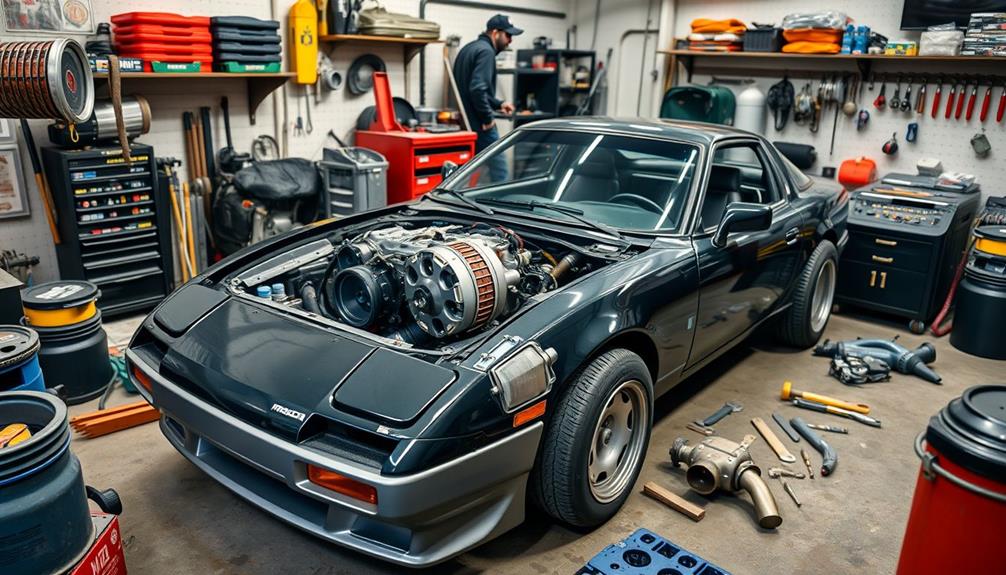
Guiding the tuning process for your Mazda RX-7 can come with its share of challenges, especially given the unique characteristics of rotary engines. One of the primary concerns is making precise timing adjustments. Retarded timing can elevate exhaust gas temperatures (EGTs), risking damage to seals if you exceed 1100°C. Monitor EGTs closely, as detonation can occur at various RPMs, signaling potential issues with your timing or air-fuel mixture.
When you're running a turbocharged setup, be aware that your timing settings will differ from naturally aspirated models. Generally, turbo engines require about 30° BTDC, while NA variants run between 18-26°. For those pushing high boost levels beyond 15 PSI, consider using race fuel or implementing water/methanol injection to minimize detonation risks.
Additionally, fluctuations in fuel pressure can disrupt your air-fuel mixture consistency. Make certain you have quality fuel lines and properly sized injectors to maintain peak performance.
Frequently Asked Questions
How Much HP Can a RX-7 Handle?
Your RX-7 can handle around 400-450bhp reliably with stock components. With modifications, you might push it over 1000bhp, but remember, stronger parts and careful tuning are essential to avoid engine damage.
What Are the 3 Weaknesses of the Rotary Engine?
The rotary engine's three main weaknesses are apex seal wear, susceptibility to detonation, and inefficient cooling. These issues can lead to power loss, potential damage, and overheating, so regular maintenance and careful tuning are essential for performance.
How Much Horsepower Does the Rotary Engine Have in the Rx-7?
You'll find the rotary engine in the RX-7 delivers a delightful range of power, typically between 252bhp and 276bhp. With tuning, it can release astonishing horsepower, turning your driving experience into something extraordinary.
Can You Tune a Rotary Engine?
Yes, you can tune a rotary engine. You'll need to adjust ignition timing and air-fuel ratios, ensuring you monitor critical parameters to avoid issues. Proper tuning can greatly enhance performance and reliability for your setup.
Conclusion
In summary, tuning your Mazda RX-7 can truly release its potential, transforming it into a beast on the road. Did you know that with the right modifications, some RX-7s can achieve over 500 horsepower? That's enough to make your heart race every time you hit the accelerator! Embrace the journey of tuning your rotary engine, and you'll not only enhance performance but also create an unforgettable driving experience that's uniquely yours.





